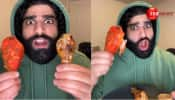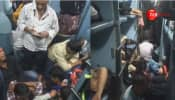San Salvador: Jose was 13 when he entered the violent, murky underworld of the "maras," the gangs that have stained Central America`s streets in blood.
Like the tens of thousands of young people who have joined these brutal urban tribes, the olive-skinned 26-year-old wears his fate tattooed on his skin -- though his are less visible than many members` full-body tattoos.
Jose, who uses a fake identity to protect himself, says his former gang, Mara Salvatrucha, was his "home."
"The gang is like a family," he told AFP in San Salvador, where he is trying to escape his past by studying and joining an evangelical church.
He used to sell drugs and extort money, and spent time in prison for murder.
"When I was caught up in that, I didn`t think about how I was going to leave people`s children, wives, mothers, fathers crying," he said.
Death is a way of life for these groups, which have become complex organized crime networks in Central America.
The region now holds four of the top five spots on the list of countries with the highest homicide rates, largely because of the gangs` culture of violence.
The bloodiest gangs are Mara Salvatrucha (MS-13) and Barrio 18, which are organized hierarchically using "clicas" -- cells that ruthlessly control blocks of territory with their own language, rules and moral code.Their most distinctive traits are tattoos -- often from head to toe -- and their graffiti tags: "Ver, oir y callar" (See, hear and shut up).
But they are using them less and less, to evade the authorities.
"They have their own forms of symbolic communication: written, verbal and kinetic, which are part of a sub-culture with clear traits of an organized structure," said Jaime Martinez, director of El Salvador`s Public Safety Academy.
Experts try to decode what`s behind these symbols.
An "18," a "13" or an "MS" tattoo is a membership badge; black tears count a killer`s hits; crosses count the number of dead comrades; clowns tell of joys and heartbreaks; skulls are a celebration of death.
"Three dots anywhere on the body represent the gangster`s life -- in the hospital, in jail or in the cemetery. Graffiti marks a clica`s territory," said a Honduran anti-gang policeman, speaking on condition of anonymity.
There are women members, too. Used in extortion rackets and to transport cash, they have to tattoo themselves with their boyfriend`s name."Joining a gang is free. It`s getting out that`s the problem," says Jose. "When you want to quit, they hunt you down and kill you. Not just you but your family too."
The initiation rite is a 13- or 18-second beating, depending on the gang, or else killing an enemy.
"A gangster`s not a gangster without a rival, if he`s never had a beating and a gun to pull the trigger," said Carlos Menocal, a former interior minister in Guatemala.
The gangsters` language is a window on their world, from the "ranfleros" or "palabreros" (windbags) who give the orders, to the "banderas" (flags) who stand sentry, to the "soldados" (soldiers) who collect extortion money, to the cash itself -- "renta" (rent) or "impuestos de guerra" (war taxes).
Every gang also has its own sign language, according to Menocal.
"The top bosses in prison, the national ranfleros, still give the orders. Someone outside tells them what`s happening. The clica bosses have a meeting every week to plan killings and extortions... everything. Everyone`s got a day-to-day mission," said Jose.
When their shake-downs and shootouts scare the neighbors away, gang members move into those homes or use them to run operations and torture enemies -- they call them "destroyer houses" or "crazy houses."
"Every gangster gets money each week to buy food, clothes and bring around family members," said Jose.
They used to wear baggy clothes but are increasingly keeping a low profile.
And they have guns of virtually every kind.
"They love nine-millimeter pistols, AK-47s, 12-gauge shotguns, which they can get quickly on the black market," said Menocal.
Fed by poverty, weak government and the break-up of the traditional family, Mara Salvatrucha and Barrio 18 emerged in the 1980s in Los Angeles`s Latino neighborhoods.
They arrived in Central America when the United States deported thousands of immigrants who had fled there to escape the civil wars that gripped the region in the late 20th century.
"We went from a Cold War between the army and the guerrillas to the post-war era and now another Cold War. But this time society`s at war with itself," said Jose.
The "maras" -- short for "marabunta," an anthill that devours everything around it -- have some 100,000 members in El Salvador, Honduras and Guatemala, and are constantly recruiting.
"The gangster lives for the moment," says Jose, the only one of the 19 comrades in his clica who is still alive.















